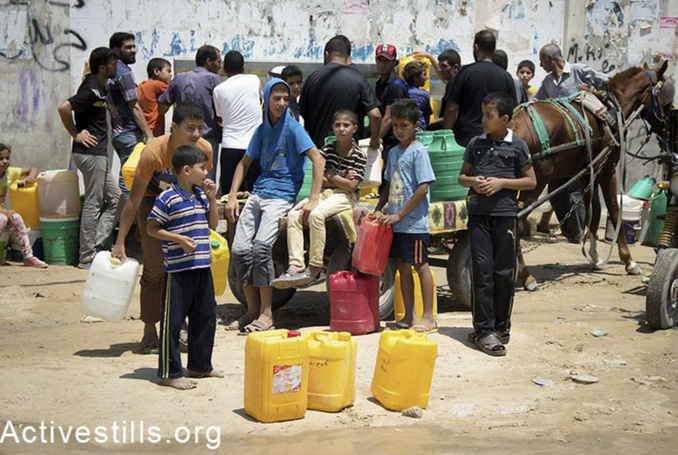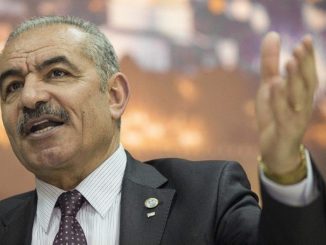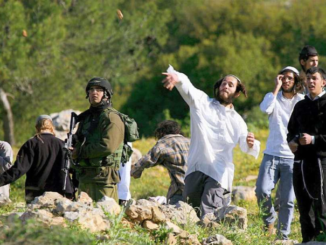
By Cihan Aksan & Jon Bailes – State of Nature
‘One Question’ is a monthly series in which we ask leading thinkers to give a brief answer to a single question. This month, we ask: What is the future of Gaza?
(With responses from: Ramzy Baroud; Richard Falk; Sara Roy; Abdalhadi Alijla; Norman Finkelstein; Toufic Haddad; Atef Alshaer; Helga Tawil-Souri; Hagar Kotef; Joel Beinin; Magid Shihade; Ran Greenstein; Richard Hardigan; Salman Abu Sitta. These are a few selected responses. To read article in full click here.)
Ramzy Baroud
Journalist, author, and editor of Palestine Chronicle. His latest book is The Last Earth: A Palestinian Story (Pluto, 2018). He has a Ph.D. in Palestine Studies from the University of Exeter and is a Non-Resident Scholar at Orfalea Center for Global and International Studies, University of California Santa Barbara. His website is www.ramzybaroud.net.
The ongoing siege on the Gaza Strip was interrupted by three major Israeli wars: in 2008/9, 2012 and 2014, with a total death toll that exceeded 5,000. Tens of thousands were wounded and maimed, and hundreds more were killed in the in-between, so-called ‘lull’ years. Coupled with a hermetic blockade, Gaza cannot rebuild most of its destroyed infrastructure, leading the United Nations to conclude that the tiny but overcrowded enclave will become ‘uninhabitable’ by 2020. In many ways, however, and tragically so, it already is.
The future of Gaza will follow the same path of horrific wars and a suffocating siege if no new positive factors are injected into this dismal equation. Without a regional and international push to force Israel to loosen its grip, or to find alternative routes to assist the isolated Strip, misery will continue, even beyond 2020. ‘Uninhabitable’ or not, Israel has no plans to allow Gaza’s 2-million inhabitants, mostly refugees from historic Palestine, today’s Israel, to lead normal lives.
It is important to note that Israel is not solely responsible for Gaza’s current fate; Egypt and the Palestinian Authority (PA) are also culpable, each with its own agenda. Egypt, which shares the Rafah border crossing with Gaza, wants to ensure that Hamas, which it perceives as an extension of the Muslim Brotherhood Movement, is isolated and weakened. The PA, which is controlled by the largest Palestinian Liberation Organisation (PLO) faction, Fatah, is also hell-bent on defeating Hamas. Fatah lost a parliamentary election to Hamas in 2006 and does not wish to repeat that perceived folly by allowing another democratic election to take place.
Thus, the Palestinian political rift is important for all parties involved: Israel needs to demonize Hamas and, by extension, all of Gaza; Egypt wants to marginalize any strong Islamic political tide, and the PA in the West Bank wants to keep its rivals at bay. Despite Hamas’ regional politicking, it has so far failed to break away from its isolation. Gaza is, therefore, not a victim of Israel alone. True, the latter owns the largest shares in Gaza’s desolation, but other Arab and Palestinian parties are greatly invested and equally keen on keeping the hapless Strip on its knees.
If the status quo persists, a backlash is on the way, not just in terms of another deadly Israeli war to ‘downgrade’ the defenses of Palestinian resistance, but also in terms of social and political upheaval in Gaza and the West Bank. The large protests against the PA in Ramallah in recent days were violently suppressed by PA police and thugs, but West Bankers are growing angry over the subjugation of their Gaza brethren. Meanwhile, the mass rallies at the Gaza-Israel fence are an indication that Gazans are seeking alternative methods to fight back, even at the price of a high death and injury toll, as has been and continues to be the case.
Richard Falk
Professor Emeritus in International Law, Princeton University; between 2008-2014 he served as Special Rapporteur for Occupied Palestine on behalf of the UN Human Rights Council; his most recent books are Power Shift: On the New Global Order (University of Chicago, 2016) and Revisiting the Vietnam War (University of Cambridge, 2017).
It is important to understand some essential features of the distinctive place of Gaza in the wider context of the Palestinian struggle for elemental rights. Perhaps most fundamentally, unlike the West Bank and Jerusalem, Gaza is not considered part of the ‘promised land’ that forms the substance of the Zionist Project to form a Jewish State that corresponds with its understanding of the scope of biblical entitlement. At the same time, Gaza has a long history of centrality in the Palestinian national experience that stretches back before the time of Mohammed, and thus the inclusion of Gaza in Palestine’s vision of self-determination is vital. This collides with Israel’s desire to maintain a Jewish majority state, which would make it desirable for Gaza to be absorbed or at least administered separately by either Jordan or Egypt.
Gaza, more than the West Bank, has also been the center of Palestinian resistance, being the site where the First Intifada was launched in 1987 and where Hamas came to govern after it prevailed in internationally supervised elections of 2006 and in a struggle for governing authority the following year. The intense hostility between Hamas and the PLO has fractured Palestinian political unity, weakening Palestinian diplomatic leverage, and making it more plausible for Israel to claim it has no Palestinian ‘partner’ in the search for a peaceful solution.
Such a background helps us understand why Gaza has experienced massively destructive attacks by Israel in 2008-09, 2012, and 2014, as well as the recent border massacre in response to the Great Return March that is the latest example of Israeli reliance on excessive violence and cruel tactics to crush Palestinian resistance.
Gaza also partakes of the wider fate of the Palestinian people, which in the time of Netanyahu and Trump seems extremely unfavorable, with respect to relief from the ordeal of a suffocating blockade that has lasted more than a decade and control policies designed to achieve de-development of the Gazan economy. In this regard, the safest prediction is a continuation of the cycle of repression and resistance with no change of basic circumstances. Even the Israeli expansionists do not seek to absorb Gaza, although its offshore deposits of natural gas might create a future temptation.
The longer vision of a Gazan future is clouded at present. Ideally, Gaza would participate in a single secular state embracing the whole of historic Palestine. Increasingly, the impracticality of the two-state solution has focused Gazan hopes either on a long-term ceasefire or a genuine peace process that establishes a single democratic state.
Sara Roy:
Senior research scholar at the Center for Middle Eastern Studies, Harvard University, specializing in the Palestinian economy, Palestinian Islamism and the Israeli-Palestinian conflict. She is also co-chair of the Middle East Seminar, jointly sponsored by the Weatherhead Center for International Affairs and the Center for Middle Eastern Studies, and co-chair of the Middle East Forum at the Center for Middle Eastern Studies. Her books include: The Gaza Strip: The Political Economy of De-development (Institute for Palestine Studies, 1995, 2001, third edition 2016 with a new introduction and afterword and Arabic edition forthcoming in 2018); Failing Peace: Gaza and the Palestinian-Israeli Conflict (Pluto Press, 2007); and Hamas and Civil Society in Gaza: Engaging the Islamist Social Sector (Princeton University Press, 2011, 2014 with a new afterword).
The question itself reflects the problem. It speaks to Gaza as separate and apart – severed from Israel, the West Bank, and the world. In this regard, Israel has been stunningly successful; it has not only removed and contained Gaza geographically, economically and legally; it has convinced us to understand and accept Gaza as something distinct and awful, unenduring, and therefore undeserving of a normal, worthwhile existence.
Gaza’s temporality has always defined Israel’s approach to the territory because Israel has never really known what to do with Gaza. Gaza has always been unruly, guilty of what for Israel is indefensible and unforgiveable: defiance. This accounts in part for Israel’s brutal treatment of the territory including a blockade now in its 12th year, which has destroyed the local economy. Gaza was – and remains – the center of Palestinian resistance to Israeli occupation and the injustice that sustains it.
The recent protests along the fence isolating Gaza from Israel, which at times exceeded 30,000 people, were a nightmare for Israel, a harbinger of things to come. No doubt one issue plaguing the Israeli government right now is how better to control Gaza. This question, I am told, is at the heart of the American peace plan (especially since the West Bank has effectively succumbed to Israeli rule). Controlling Gaza in the future, however, will be no different from the past. Gaza will continue to be treated as a humanitarian problem requiring nothing more than subsistence relief. Defining the parameters of Israel’s policy toward the territory, an Israeli defense official was clear and succinct: ‘No development, no prosperity, no humanitarian crisis.’
Gaza’s future must be informed by its past; yet, its lived reality has no connection to a past or a future. The majority of Gazans have no memory of Gaza before the destruction. History – both recent and far – is not so much absent as it is vacant, and without that history to navigate a way forward, there are no prospects worth thinking about or expectations worth having. People are so consumed by the present that mundane needs have become aspirational. The future is beyond conceptualization.
If Gaza has a future outside incarceration, it lies in ending its liminality and present state of exception. It lies in admittance and inclusion. And it lies in returning to Gazans what they want most – a predictable, unexceptional life.
Norman Finkelstein
Received his Ph.D. from the Princeton University Politics Department. He has written many books, including The Holocaust Industry: Reflections on the Exploitation of Jewish Suffering (Verso, 2000), and most recently, Gaza: An Inquest into its Martyrdom (University of California, 2018).
The modern history of Gaza begins in 1948 with the massive influx of expellees from the newborn state of Israel. In 1967, Gaza came under a brutal Israeli occupation. Israel alleges that it withdrew from Gaza in 2005, but the consensus among legal specialists – including top Israeli authority Yoram Dinstein – is that Israel remains the occupying power. In 2006, after Hamas won ‘completely honest and fair elections’ (Jimmy Carter), Israel imposed a medieval-like blockade on Gaza. In the meantime, Israel has visited not fewer than eight ‘operations’ on Gaza since 2004. After the last massacre, Operation Protective Edge (2014), President of the International Committee of the Red Cross, Peter Maurer, went to Gaza and observed, ‘I’ve never seen such massive destruction ever before.’
UN agencies have now pronounced Gaza ‘unlivable.’ ’I see this extraordinarily inhuman and unjust process of strangling gradually two million civilians that really pose a threat to nobody,’ UN humanitarian coordinator for Gaza, Robert Piper, observed last year. Echoing him, UN Human Rights chief, Zeid Ra’ad al-Hussein, recently deplored the fact that Gazans have been ‘caged in a toxic slum from birth to death.’
On March 30, the people of Gaza initiated weekly mass demonstrations to break the illegal siege. Human rights groups report that the marches have been overwhelmingly peaceful. But more than 110 Gazans have been killed and more than 3,700 injured (many permanently) with live ammunition by Israeli snipers. ‘Israeli forces’ repeated use of lethal force in the Gaza Strip since March 30, 2018, against Palestinian demonstrators who posed no imminent threat to life,’ Human Rights Watch concluded in a major investigation, ‘may amount to war crimes.’
What is the future of Gaza?
Sara Roy of Harvard University’s Center for Middle Eastern Studies has observed that ‘innocent human beings, most of them young, are slowly being poisoned by the water they drink, and likely by the soil in which they plant.’ Experts say that before long Gaza will be overrun by typhoid and cholera epidemics. It is impossible to predict the future except to say, if the international community doesn’t act, Gaza won’t have one.
A 2015 UN report by New York State judge Mary McGowan Davis called on Israel to lift the blockade ‘immediately and unconditionally,’ while the European Parliament in 2018 called for an ‘immediate and unconditional end to the blockade.’ If Israel isn’t compelled to end the illegal and inhuman siege, the judgment of History will not be kind. Will it one day be asked, why was the world silent when Gaza was crucified?
Salman Abu Sitta
A writer and activist on Palestinian refugees and the Right of Return. He has authored over 300 papers and articles and five books including the encyclopedic Atlas of Palestine 1948 and the expanded Atlas of Palestine 1917- 1966 published in 2010. He is founder and president of the Palestine Land Society, UK, for the purpose of documenting the land and people of Palestine. The society website has a wealth of information at www.plands.org.
Gaza is the symbol of Palestine. Gaza is the part of Palestine which never willingly raised a flag other than that of Palestine. Gaza represents the conscience of the Palestinian people, which can express itself freely (most of the time), unlike in other regions in Palestine, under Israeli rule.
Gaza is not only the symbol but the center of resistance to the occupation of a homeland. In Gaza, the first commando operations to liberate occupied Palestine started in 1950. In Gaza, demonstrations against settling Palestinians in Sinai in 1954 and 1955 were met with killings and jail sentences. The cry of the people in the streets was ‘we want to return home, not further exile.’
In Gaza, the first popular movements to liberate occupied Palestine started just after al-Nakba. Fatah, Arab Nationalists, Muslim Brothers and Communists each vied to find the best strategy to liberate Palestine throughout most of the 1950s.
In Gaza, the first democratically elected Palestine Legislative Council was formed in 1961. From Gaza, the first Palestinian delegation traveled to New York in 1962 to address the UN on behalf of the Palestinian people. All previous representations at the UN had been made by Arab League members.
Why is Gaza Strip the most crowded place on Earth?
During the British Mandate on Palestine (1920- 1948), Britain, in contravention of its obligations to bring independence to Palestine, allowed European Jewish settlers to come to Palestine. During this period, the settlers, with British collusion, managed to control only 6% of Palestine. Armed and trained by the British, these Zionist settlers (later called Israelis) depopulated 675 Palestinian towns and villages and occupied by military force 80% of Palestine in 1948/49, after the unceremonious British departure.
Nowhere are the effects more striking than in southern Palestine. The southern half (50%) of Palestine was totally ethnically cleansed by the Israelis and the inhabitants of 247 villages have been pushed into 1.3% of the territory. That is the Gaza Strip. They now live in 8 refugee camps at a density of 7000 people/km2.
They literally see their land and homes across the barbed wire. Their land is still empty; the settlers’ density is only 7 people/km2.
The longest standing resolution in UN history since 1948, UNGA resolution 194, calls for the return of the refugees to their homes.
Three generations of refugees, as the youngest eloquently demonstrated in April and May 2018, insist on their Right of Return. There can never be any peace in the region without the right of 7 million Palestinian refugees to return to their homes, now occupied by 2% of Israelis.
The future of the whole region resides in Palestine. And the future of Palestine resides in Gaza. And the future of Gaza is in the Right of Return. And that calls for justice, well overdue.
To read responses in full, click here…







